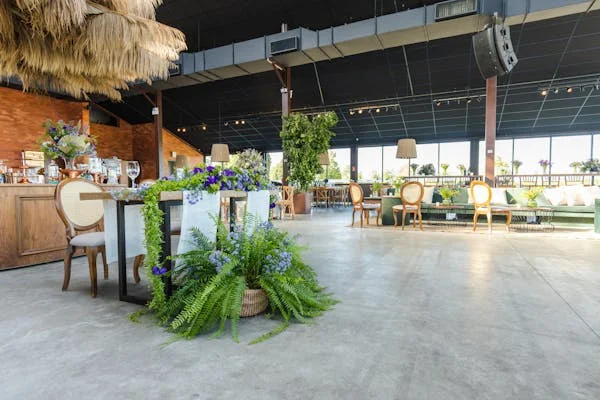Hospitality is undergoing an extraordinary change. Everywhere, restaurants are always looking for new ways to wow their customers and guarantee seamless operation. The way furniture is designed, manufactured, and incorporated into business dining areas is one important driver of this change. To produce modern surroundings that attract both business owners and their consumers, new technologies are altering the appearance, feel, and function of restaurant furniture.
Smart systems, sophisticated materials, and digital improvements, among other creative ideas, are elevating the hotel experience. The worldwide furniture market, meanwhile, is expected to generate a significant US$799.46 billion by 2025, suggesting plenty of space for companies to invest in innovative design. The United States, in reality, is predicted to top in total income, hitting US$274 billion in the same year. Restaurant owners can distinguish themselves from the competition and provide their customers with a dining experience that is both pleasant and motivating by adopting technological developments.
Smart Furniture: Integrating IoT into Hospitality Spaces
Smart furniture is changing the way restaurants serve their guests from restaurant booths with built-in charging to smart restaurant tables, and managing day-to-day tasks. Internet of Things (IoT) innovations allow items like tables and chairs to connect with management systems, enabling features such as wireless device charging or occupancy monitoring. These capabilities help business owners optimize seating arrangements, streamline cleaning schedules, and improve customer satisfaction.
Beyond convenience, IoT-driven systems also bring benefits in the form of predictive maintenance. Sensors placed in chairs or tabletops can track usage patterns and alert restaurant managers when repairs or replacements might be needed. With access to real-time data, owners can make smarter decisions about furniture upkeep and guest comfort.
Sustainable Materials: Eco-Friendly Furniture Innovations
Increasing awareness of sustainable practices has spurred a rise in eco-friendly furniture choices for the hotel industry. Reflecting a change toward environmentally responsible sourcing, recycled plastics, bioengineered wood, and renewable fibers are becoming more common commodities. These eco-friendly options appeal to consumers who appreciate mindful consumption and help to lower waste. Making sustainability affordable and feasible depends much on technological developments. Better manufacturing techniques have kept excellent quality while reducing prices. Therefore, more restaurants can include sustainable components in their interiors without compromising design allure. Many governments and industry authorities in many areas also support environmentally friendly projects, hence giving more motivation for companies to think about greener options.
3D Printing Revolutionizing Restaurant Furniture
Three-dimensional printing offers nearly limitless potential for creating restaurant furniture that stands out. Designs can be customized quickly, allowing unique shapes, textures, and sizes that align with a brand’s identity. Often, 3D printing also shortens production timelines compared to traditional manufacturing methods.
Over the past few years, material quality in 3D printing has improved significantly, enhancing the strength and durability of printed furniture. Looking ahead, larger industrial 3D printers may enable the mass customization of tables, chairs, and other fixtures, all while keeping costs manageable. This combination of speed, flexibility, and cost-effectiveness positions 3D printing as a powerful technology for future-focused restaurant owners.
Augmented Reality (AR) and Virtual Reality (VR) in Furniture Design
Though AR and VR technologies are helping to simplify it, designing a commercial restaurant layout can be difficult. By means of these technologies, architects and designers may see in detail areas before any building starts, therefore lowering the possibility of errors and resource loss. Restaurant owners may virtually preview designs to guarantee that furniture is both useful and aesthetically pleasing.
These tools also help to make remote cooperation more feasible. Teams spread across several sites can view the same virtual model, discuss possible layout modifications, and immediately see how those changes would appear in a genuine digital world. Further development of AR and VR might change conventional approaches to choosing, organizing, and putting restaurant furniture in place.
The Role of Automation and Robotics in Restaurant Furniture
Automation and robotics are quickly gaining ground in the hospitality world, offering solutions that range from automated seating arrangements to self-cleaning surfaces. Automated systems can handle repetitive tasks such as reorganizing tables or sanitizing furniture, freeing staff to focus on delivering outstanding service to customers.
Often, automation not only improves efficiency but also enhances cleanliness and safety. Self-cleaning tables, for example, can reduce the spread of germs while maintaining a consistently polished appearance. Although robotic furniture may involve a higher initial investment, its benefits in terms of labor savings and operational consistency can justify the cost in the long run.
Digital Integration: Interactive Furniture and Customer Engagement
Modern commercial-grade restaurant furniture can do more than provide a place to sit or eat. Interactive elements such as built-in screens, tabletop ordering systems, and other embedded technologies are now available to entertain and inform diners. Touchless technology, in particular, has grown in importance, offering a convenient way for guests to browse menus, place orders, or request assistance without direct contact.
Digital integrations can also gather valuable insights that help shape marketing strategies. Customer preferences, item popularity, and average dwell times may be tracked to refine menus, organize promotions, and maximize overall efficiency. That level of personalization often leads to happier guests who are more likely to return and recommend the establishment to others.
Global Furniture Market Insights and Growth Opportunities
The worldwide furniture market is on an upward trajectory, with a projected Compound Annual Growth Rate (CAGR) of 3.73% from 2025 to 2029. By 2025, per capita revenue in this market is expected to reach around US$102.33, reflecting the strong global demand for new and innovative furniture. One driving factor behind this rise is the ever-increasing urbanization, especially in countries like China, where disposable incomes are on the rise.
These trends create exciting possibilities for restaurants looking to upgrade or expand. In emerging markets such as India and parts of Southeast Asia, the growing middle class and changing consumer preferences point toward further opportunities for hospitality businesses. Understanding these shifts can help suppliers and restaurateurs strategically position themselves to succeed in competitive environments.
Where Innovation Meets Hospitality: A Vision for Tomorrow
Commercial restaurant furniture is always evolving due to technology, which combines creativity, functionality, and style. Every new development offers new methods to improve the dining experience, from green materials that represent ethical environmental practices to smart sensors that assist in seating optimization. The worldwide furniture market’s explosive expansion demonstrates how much room there is for innovators to bring about significant change.
Restaurant owners may have a distinct advantage in providing memorable meals in the future if they keep up with these trends. Businesses can create a welcome environment that draws clients by combining contemporary features with cozy, eye-catching objects. Commercial restaurant furniture has a bright future for those willing to adopt new concepts, whether it is through advanced digital interaction, robotics that streamline daily tasks, or 3D printing that adds flair.





